BSBHRM513: Monitor and Evaluate Workforce Planning at JKL Company
VerifiedAdded on 2023/06/11
|7
|1263
|179
Report
AI Summary
This report assesses the implementation of a workforce planning strategy within JKL Company, addressing critical aspects such as labor forecasting, the impact of government policies, and the significance of organizational climate. It highlights the importance of accurate labor forecasting to avoid both understaffing and overstaffing, and emphasizes the need for businesses to engage with policymakers to ensure favorable regulatory conditions. The report also explores the role of employee climate surveys in identifying issues such as lack of privacy, inadequate breaks, and safety concerns that contribute to employee attrition. Recommendations include adopting quantitative labor forecasting methods, proactive engagement with government officials, and improvements in employee privacy, safety, and break policies. The conclusion underscores the importance of effective communication between management and employees, as well as strategic labor management for overall company success. The bibliography lists relevant sources used in the report. Desklib is a great platform to find such solved assignments.
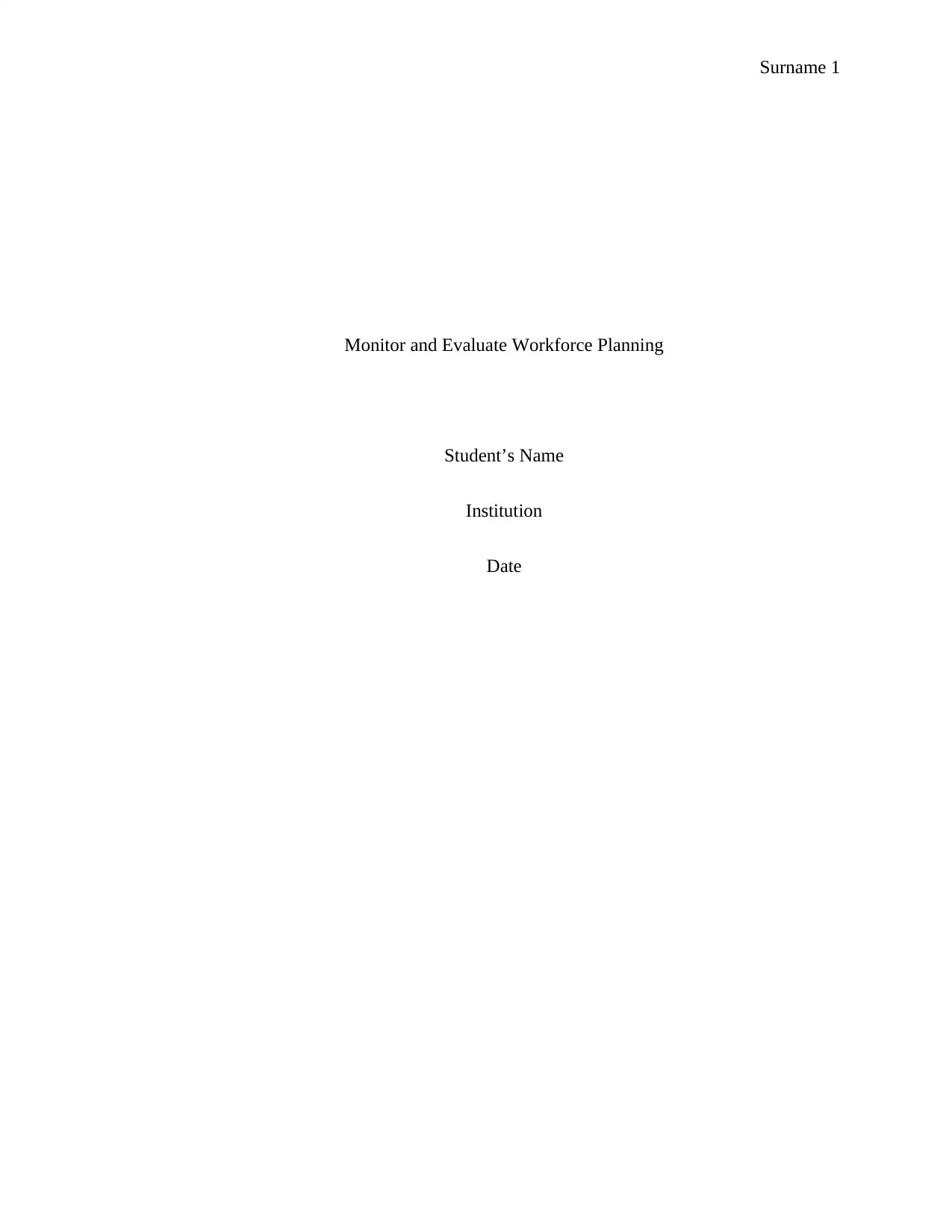
Surname 1
Monitor and Evaluate Workforce Planning
Student’s Name
Institution
Date
Monitor and Evaluate Workforce Planning
Student’s Name
Institution
Date
Paraphrase This Document
Need a fresh take? Get an instant paraphrase of this document with our AI Paraphraser
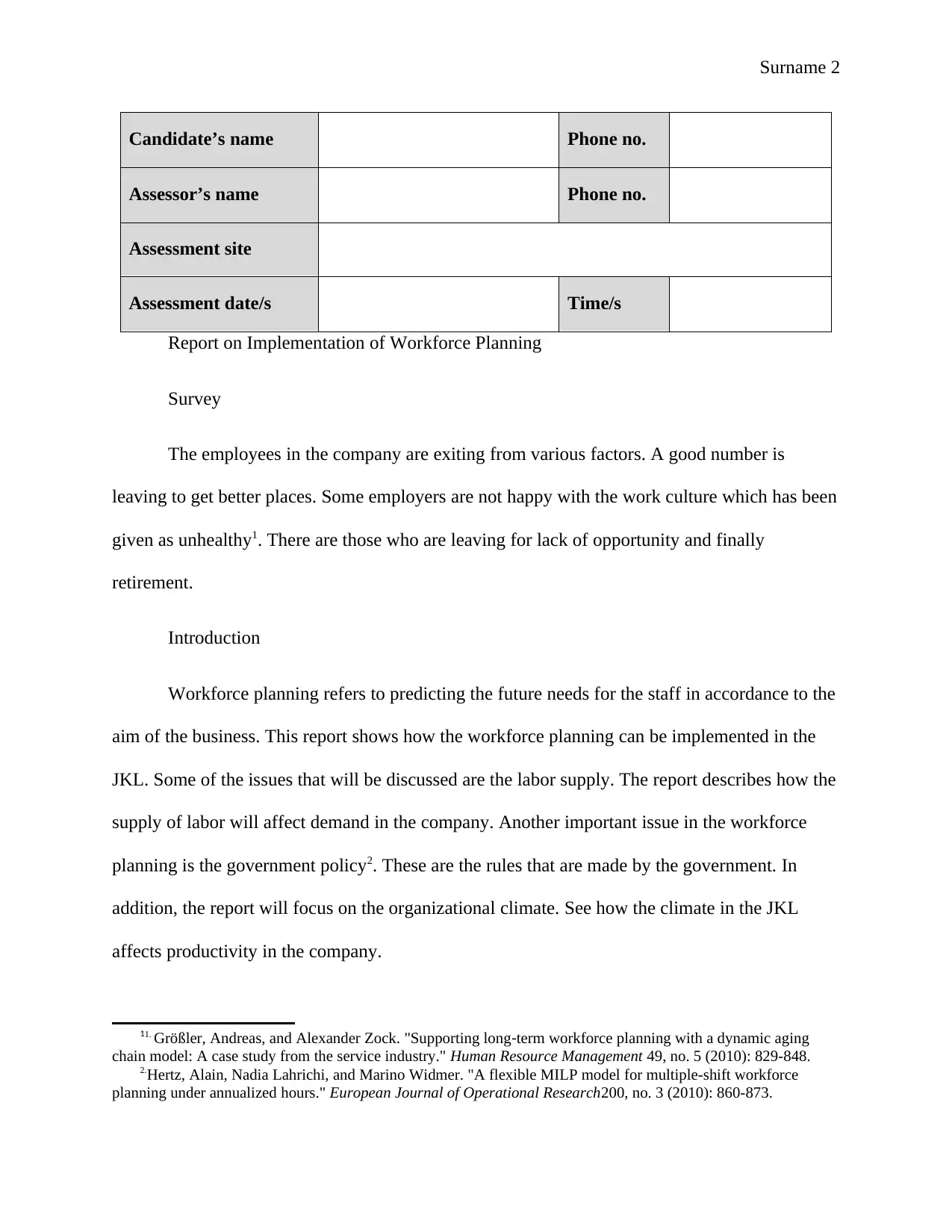
Surname 2
Candidate’s name Phone no.
Assessor’s name Phone no.
Assessment site
Assessment date/s Time/s
Report on Implementation of Workforce Planning
Survey
The employees in the company are exiting from various factors. A good number is
leaving to get better places. Some employers are not happy with the work culture which has been
given as unhealthy1. There are those who are leaving for lack of opportunity and finally
retirement.
Introduction
Workforce planning refers to predicting the future needs for the staff in accordance to the
aim of the business. This report shows how the workforce planning can be implemented in the
JKL. Some of the issues that will be discussed are the labor supply. The report describes how the
supply of labor will affect demand in the company. Another important issue in the workforce
planning is the government policy2. These are the rules that are made by the government. In
addition, the report will focus on the organizational climate. See how the climate in the JKL
affects productivity in the company.
11. Größler, Andreas, and Alexander Zock. "Supporting long‐term workforce planning with a dynamic aging
chain model: A case study from the service industry." Human Resource Management 49, no. 5 (2010): 829-848.
2.Hertz, Alain, Nadia Lahrichi, and Marino Widmer. "A flexible MILP model for multiple-shift workforce
planning under annualized hours." European Journal of Operational Research200, no. 3 (2010): 860-873.
Candidate’s name Phone no.
Assessor’s name Phone no.
Assessment site
Assessment date/s Time/s
Report on Implementation of Workforce Planning
Survey
The employees in the company are exiting from various factors. A good number is
leaving to get better places. Some employers are not happy with the work culture which has been
given as unhealthy1. There are those who are leaving for lack of opportunity and finally
retirement.
Introduction
Workforce planning refers to predicting the future needs for the staff in accordance to the
aim of the business. This report shows how the workforce planning can be implemented in the
JKL. Some of the issues that will be discussed are the labor supply. The report describes how the
supply of labor will affect demand in the company. Another important issue in the workforce
planning is the government policy2. These are the rules that are made by the government. In
addition, the report will focus on the organizational climate. See how the climate in the JKL
affects productivity in the company.
11. Größler, Andreas, and Alexander Zock. "Supporting long‐term workforce planning with a dynamic aging
chain model: A case study from the service industry." Human Resource Management 49, no. 5 (2010): 829-848.
2.Hertz, Alain, Nadia Lahrichi, and Marino Widmer. "A flexible MILP model for multiple-shift workforce
planning under annualized hours." European Journal of Operational Research200, no. 3 (2010): 860-873.
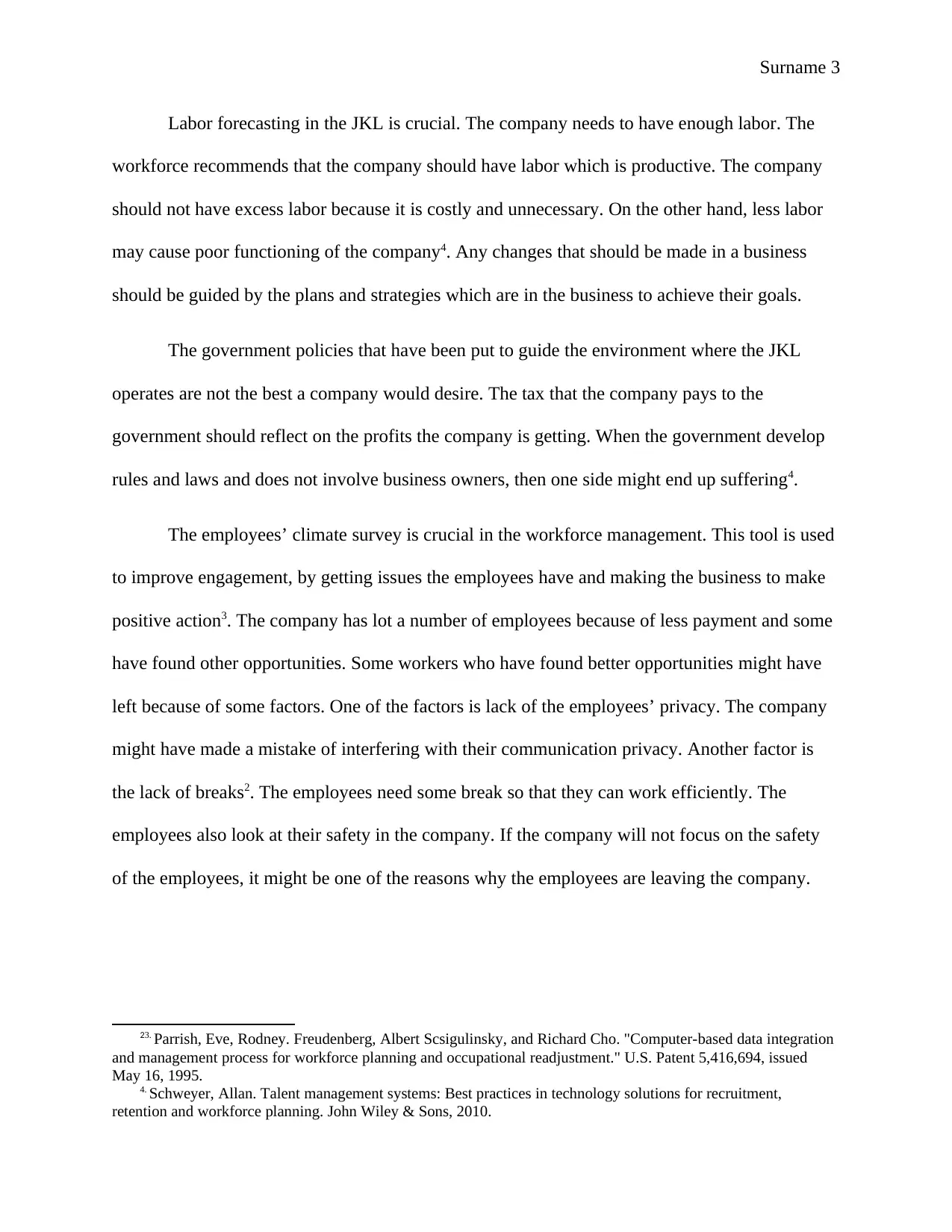
Surname 3
Labor forecasting in the JKL is crucial. The company needs to have enough labor. The
workforce recommends that the company should have labor which is productive. The company
should not have excess labor because it is costly and unnecessary. On the other hand, less labor
may cause poor functioning of the company4. Any changes that should be made in a business
should be guided by the plans and strategies which are in the business to achieve their goals.
The government policies that have been put to guide the environment where the JKL
operates are not the best a company would desire. The tax that the company pays to the
government should reflect on the profits the company is getting. When the government develop
rules and laws and does not involve business owners, then one side might end up suffering4.
The employees’ climate survey is crucial in the workforce management. This tool is used
to improve engagement, by getting issues the employees have and making the business to make
positive action3. The company has lot a number of employees because of less payment and some
have found other opportunities. Some workers who have found better opportunities might have
left because of some factors. One of the factors is lack of the employees’ privacy. The company
might have made a mistake of interfering with their communication privacy. Another factor is
the lack of breaks2. The employees need some break so that they can work efficiently. The
employees also look at their safety in the company. If the company will not focus on the safety
of the employees, it might be one of the reasons why the employees are leaving the company.
23. Parrish, Eve, Rodney. Freudenberg, Albert Scsigulinsky, and Richard Cho. "Computer-based data integration
and management process for workforce planning and occupational readjustment." U.S. Patent 5,416,694, issued
May 16, 1995.
4. Schweyer, Allan. Talent management systems: Best practices in technology solutions for recruitment,
retention and workforce planning. John Wiley & Sons, 2010.
Labor forecasting in the JKL is crucial. The company needs to have enough labor. The
workforce recommends that the company should have labor which is productive. The company
should not have excess labor because it is costly and unnecessary. On the other hand, less labor
may cause poor functioning of the company4. Any changes that should be made in a business
should be guided by the plans and strategies which are in the business to achieve their goals.
The government policies that have been put to guide the environment where the JKL
operates are not the best a company would desire. The tax that the company pays to the
government should reflect on the profits the company is getting. When the government develop
rules and laws and does not involve business owners, then one side might end up suffering4.
The employees’ climate survey is crucial in the workforce management. This tool is used
to improve engagement, by getting issues the employees have and making the business to make
positive action3. The company has lot a number of employees because of less payment and some
have found other opportunities. Some workers who have found better opportunities might have
left because of some factors. One of the factors is lack of the employees’ privacy. The company
might have made a mistake of interfering with their communication privacy. Another factor is
the lack of breaks2. The employees need some break so that they can work efficiently. The
employees also look at their safety in the company. If the company will not focus on the safety
of the employees, it might be one of the reasons why the employees are leaving the company.
23. Parrish, Eve, Rodney. Freudenberg, Albert Scsigulinsky, and Richard Cho. "Computer-based data integration
and management process for workforce planning and occupational readjustment." U.S. Patent 5,416,694, issued
May 16, 1995.
4. Schweyer, Allan. Talent management systems: Best practices in technology solutions for recruitment,
retention and workforce planning. John Wiley & Sons, 2010.
⊘ This is a preview!⊘
Do you want full access?
Subscribe today to unlock all pages.

Trusted by 1+ million students worldwide
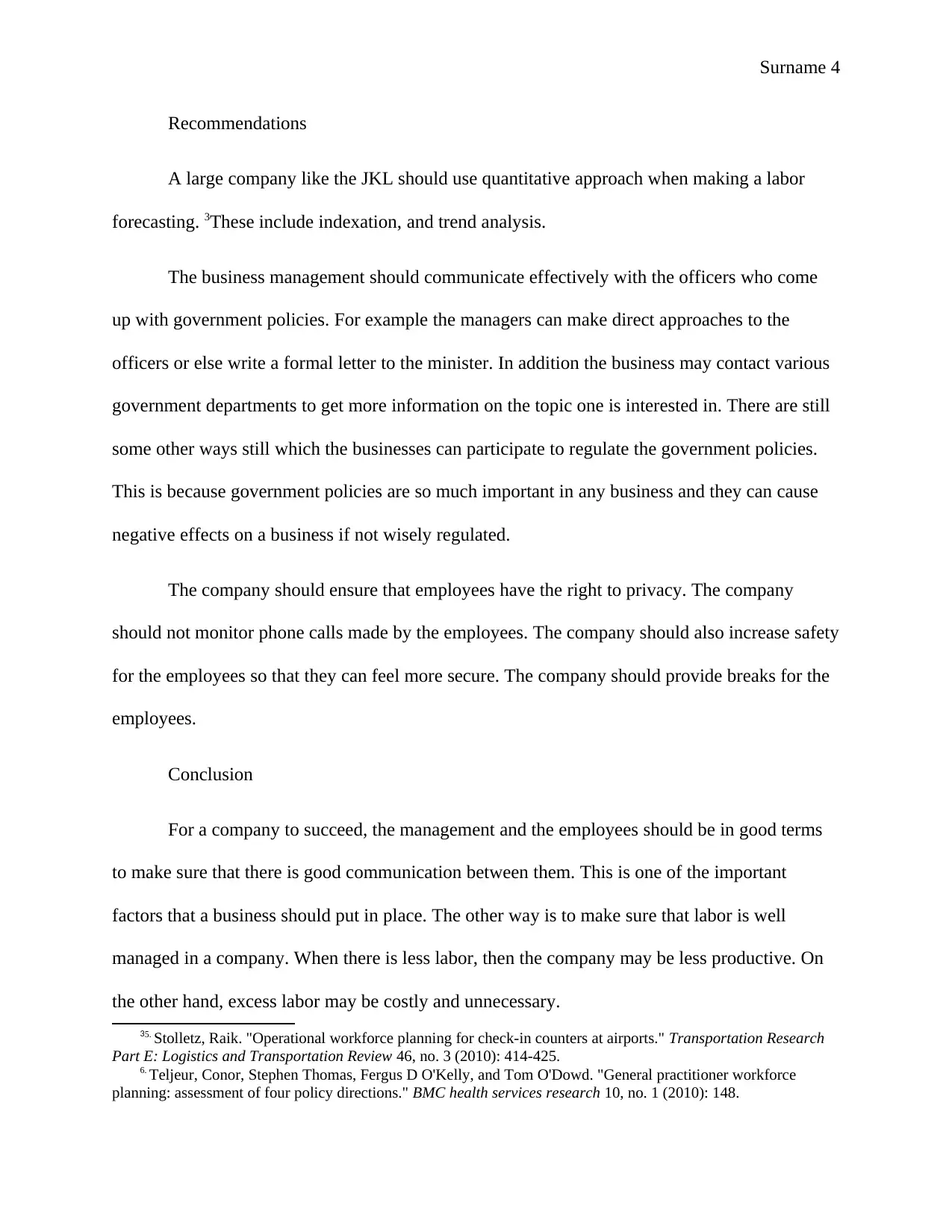
Surname 4
Recommendations
A large company like the JKL should use quantitative approach when making a labor
forecasting. 3These include indexation, and trend analysis.
The business management should communicate effectively with the officers who come
up with government policies. For example the managers can make direct approaches to the
officers or else write a formal letter to the minister. In addition the business may contact various
government departments to get more information on the topic one is interested in. There are still
some other ways still which the businesses can participate to regulate the government policies.
This is because government policies are so much important in any business and they can cause
negative effects on a business if not wisely regulated.
The company should ensure that employees have the right to privacy. The company
should not monitor phone calls made by the employees. The company should also increase safety
for the employees so that they can feel more secure. The company should provide breaks for the
employees.
Conclusion
For a company to succeed, the management and the employees should be in good terms
to make sure that there is good communication between them. This is one of the important
factors that a business should put in place. The other way is to make sure that labor is well
managed in a company. When there is less labor, then the company may be less productive. On
the other hand, excess labor may be costly and unnecessary.
35. Stolletz, Raik. "Operational workforce planning for check-in counters at airports." Transportation Research
Part E: Logistics and Transportation Review 46, no. 3 (2010): 414-425.
6. Teljeur, Conor, Stephen Thomas, Fergus D O'Kelly, and Tom O'Dowd. "General practitioner workforce
planning: assessment of four policy directions." BMC health services research 10, no. 1 (2010): 148.
Recommendations
A large company like the JKL should use quantitative approach when making a labor
forecasting. 3These include indexation, and trend analysis.
The business management should communicate effectively with the officers who come
up with government policies. For example the managers can make direct approaches to the
officers or else write a formal letter to the minister. In addition the business may contact various
government departments to get more information on the topic one is interested in. There are still
some other ways still which the businesses can participate to regulate the government policies.
This is because government policies are so much important in any business and they can cause
negative effects on a business if not wisely regulated.
The company should ensure that employees have the right to privacy. The company
should not monitor phone calls made by the employees. The company should also increase safety
for the employees so that they can feel more secure. The company should provide breaks for the
employees.
Conclusion
For a company to succeed, the management and the employees should be in good terms
to make sure that there is good communication between them. This is one of the important
factors that a business should put in place. The other way is to make sure that labor is well
managed in a company. When there is less labor, then the company may be less productive. On
the other hand, excess labor may be costly and unnecessary.
35. Stolletz, Raik. "Operational workforce planning for check-in counters at airports." Transportation Research
Part E: Logistics and Transportation Review 46, no. 3 (2010): 414-425.
6. Teljeur, Conor, Stephen Thomas, Fergus D O'Kelly, and Tom O'Dowd. "General practitioner workforce
planning: assessment of four policy directions." BMC health services research 10, no. 1 (2010): 148.
Paraphrase This Document
Need a fresh take? Get an instant paraphrase of this document with our AI Paraphraser

Surname 5
Bibliography
Bibliography
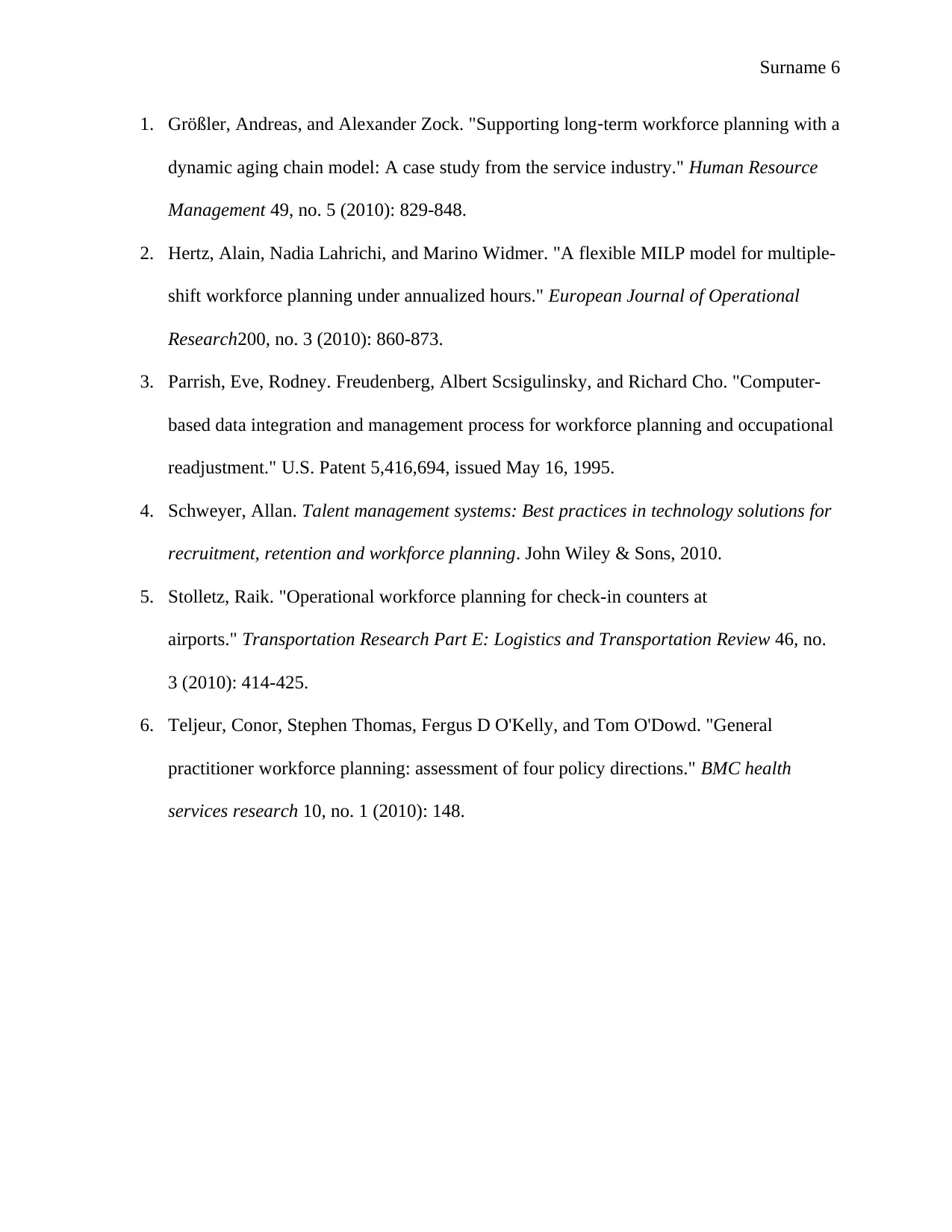
Surname 6
1. Größler, Andreas, and Alexander Zock. "Supporting long‐term workforce planning with a
dynamic aging chain model: A case study from the service industry." Human Resource
Management 49, no. 5 (2010): 829-848.
2. Hertz, Alain, Nadia Lahrichi, and Marino Widmer. "A flexible MILP model for multiple-
shift workforce planning under annualized hours." European Journal of Operational
Research200, no. 3 (2010): 860-873.
3. Parrish, Eve, Rodney. Freudenberg, Albert Scsigulinsky, and Richard Cho. "Computer-
based data integration and management process for workforce planning and occupational
readjustment." U.S. Patent 5,416,694, issued May 16, 1995.
4. Schweyer, Allan. Talent management systems: Best practices in technology solutions for
recruitment, retention and workforce planning. John Wiley & Sons, 2010.
5. Stolletz, Raik. "Operational workforce planning for check-in counters at
airports." Transportation Research Part E: Logistics and Transportation Review 46, no.
3 (2010): 414-425.
6. Teljeur, Conor, Stephen Thomas, Fergus D O'Kelly, and Tom O'Dowd. "General
practitioner workforce planning: assessment of four policy directions." BMC health
services research 10, no. 1 (2010): 148.
1. Größler, Andreas, and Alexander Zock. "Supporting long‐term workforce planning with a
dynamic aging chain model: A case study from the service industry." Human Resource
Management 49, no. 5 (2010): 829-848.
2. Hertz, Alain, Nadia Lahrichi, and Marino Widmer. "A flexible MILP model for multiple-
shift workforce planning under annualized hours." European Journal of Operational
Research200, no. 3 (2010): 860-873.
3. Parrish, Eve, Rodney. Freudenberg, Albert Scsigulinsky, and Richard Cho. "Computer-
based data integration and management process for workforce planning and occupational
readjustment." U.S. Patent 5,416,694, issued May 16, 1995.
4. Schweyer, Allan. Talent management systems: Best practices in technology solutions for
recruitment, retention and workforce planning. John Wiley & Sons, 2010.
5. Stolletz, Raik. "Operational workforce planning for check-in counters at
airports." Transportation Research Part E: Logistics and Transportation Review 46, no.
3 (2010): 414-425.
6. Teljeur, Conor, Stephen Thomas, Fergus D O'Kelly, and Tom O'Dowd. "General
practitioner workforce planning: assessment of four policy directions." BMC health
services research 10, no. 1 (2010): 148.
⊘ This is a preview!⊘
Do you want full access?
Subscribe today to unlock all pages.

Trusted by 1+ million students worldwide

Surname 7
1 out of 7
Related Documents
Your All-in-One AI-Powered Toolkit for Academic Success.
+13062052269
info@desklib.com
Available 24*7 on WhatsApp / Email
![[object Object]](/_next/static/media/star-bottom.7253800d.svg)
Unlock your academic potential
Copyright © 2020–2025 A2Z Services. All Rights Reserved. Developed and managed by ZUCOL.





